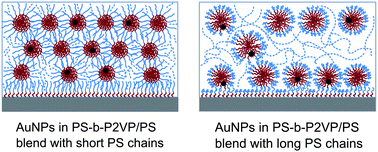Nanoparticle encapsulation in thin film micellar structures: a physical method for functional materials design†
Abstract
We investigate the confinement of

* Corresponding authors
a
Department of Materials Science and Engineering, University of Michigan, Ann Arbor, Ann Arbor, USA
E-mail:
pfgreen@umich.edu
We investigate the confinement of

 Please wait while we load your content...
Something went wrong. Try again?
Please wait while we load your content...
Something went wrong. Try again?
J. Zhao, X. C. Chen and P. F. Green, Soft Matter, 2013, 9, 6128 DOI: 10.1039/C3SM50175B
To request permission to reproduce material from this article, please go to the Copyright Clearance Center request page.
If you are an author contributing to an RSC publication, you do not need to request permission provided correct acknowledgement is given.
If you are the author of this article, you do not need to request permission to reproduce figures and diagrams provided correct acknowledgement is given. If you want to reproduce the whole article in a third-party publication (excluding your thesis/dissertation for which permission is not required) please go to the Copyright Clearance Center request page.
Read more about how to correctly acknowledge RSC content.
 Fetching data from CrossRef.
Fetching data from CrossRef.
This may take some time to load.
Loading related content
